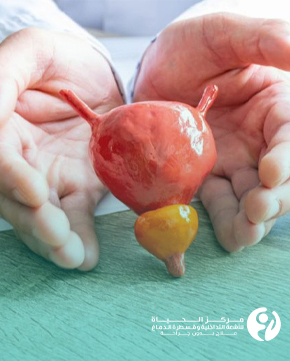
At Al Hayat Center for Interventional Radiology and Neurointervention, we are always glad to receive your inquiries and questions, and this article is dedicated to answering the most common questions regarding the treatment of prostate diseases.
Prostate enlargement is one of the most common diseases among men, affecting most men after the age of 40.
The prostate gland is one of the glands that increases in size with age and has complications affecting the urinary system and reproductive health.
What is interventional radiology treatment for prostate disease?
Interventional radiology has emerged as a treatment for benign prostatic hyperplasia, replacing delicate surgeries with serious complications and costly procedures.
Interventional radiology treatment techniques rely on the following:
X-rays, high-precision ultrasound, as well as thermal therapy that targets enlarged prostate tissue.
Or, in the case of benign prostatic hyperplasia, the prostate is injected through an arterial catheter with substances that help it shrink.
Compared to pharmacological treatment, in which the patient must continue for a long period and is exposed to its side effects, medications are not considered a definitive treatment for benign prostatic hyperplasia. Compared to surgical treatment, which requires undergoing general anesthesia and going through a recovery period after the procedure, also exposes the patient to many critical complications in reproductive health and the urinary system.
When comparing different treatment options, interventional radiology for prostate disease is the best option.
What are the symptoms of benign prostatic hyperplasia?
- Feeling an urgent and frequent need to urinate with difficulty in passing urine.
- Difficulty in controlling urine.
- Frequent urination with an inability to fully empty the bladder.
- Discharge associated with urethritis.
- Pain and burning sensation when urinating.
- Blood in the urine.
Symptoms of benign prostatic hyperplasia vary from person to person and may or may not have associated painful symptoms, depending on several factors including:
- The extent to which the prostate enlargement has worsened.
- Genetic and hereditary factors.
- Comorbidity of other diseases such as diabetes, heart disease, hypertension, and urological diseases.
- Lifestyle and diet.
- Taking certain types of heart medications.
What are the complications of an enlarged prostate?
- Recurrent urinary tract infections.
- Bladder stones.
- Kidney deterioration and an elevated blood creatinine level.
What are the causes of an enlarged prostate at an early age?
It is common for men over the age of 50 to develop an enlarged prostate, but a proportion of patients appear between the ages of 20 and 30. The causes of prostate enlargement at an early age include:
- Obesity and overeating processed food.
- Reliance on red meat increases testosterone levels.
- Smoking and exposure to tobacco products.
- The use of testosterone boosters to build muscle in gyms.
- Excessive coffee and caffeine intake.
- A sedentary lifestyle and lack of regular exercise.
What are the advantages of interventional radiology treatment for prostate disease?
- Interventional radiology is one of the best treatments for prostate enlargement, as it provides a quick treatment that does not take time for the patient to recover but rather quickly returns to his previous lifestyle and does not need to take medications for some time and expose to their side effects.
- It is also the best treatment option for elderly benign prostatic hyperplasia patients who are not eligible to undergo surgery, as they suffer from hypertension and heart disease, and surgeries may be deteriorate their health conditions and expose them to many unbearable complications.
- It is effective in treating advanced cases of prostate enlargement. Interventional radiology uses effective techniques that reduce blood flow to the prostate, thus shrinking the organ without the need to remove any part of it, regardless of its size.
- Interventional radiology does not affect the urinary system, unlike some surgical procedures in which the patient must have a urinary catheter for some time, resulting in a urinary tract infection, taking antibiotics, and possibly hospitalization for a while.
- There is also no need for anesthesia during interventional radiology procedures, making them safer than surgical procedures that require a recovery period and follow-up.
Disadvantages of interventional radiology treatment of prostate diseases:
Minor complications may occur, such as:
- Bleeding.
- Infection: Interventional radiology may require a procedure such as catheterization, just like any therapeutic procedure.
- The cost: Due to the precision of interventional radiology techniques and its reliance on modern equipment, it may be more expensive than other treatment options.
- The complexity of the procedure: It is important to choose a specialized center that is trusted and experienced with enlarged prostate cases, according to patient testimonials.
Interventional radiology for the prostate and fertility:
because of the importance of the prostate gland to reproductive health, many are now turning to interventional radiology. It has less impact on the vital functions of the prostate. It is the best option for young patients who plan to have children in the future.
Cost of Interventional Radiology for Prostate:
The cost varies depending on the type of case, its progress, and the techniques used.
In Al Hayat Center for Interventional Radiology and Neurointervention, the cost is supported by Holy Sherine of Imam Hussein.
Contact Al Hayat Center for Interventional Radiology and Neurointervention Call on:
07744700048
07744700047
Or email us at:
Alhayatcenter2023@gmail.com

